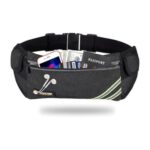Table of Contents
Introduction:
1. Understanding Heart Rate Monitors
Modern heart rate monitors offer more than just real-time numbers; they provide a gateway into understanding your body’s signals and optimizing your fitness regimen. By accurately tracking your beats per minute, these devices help you gauge the intensity of your workouts, enabling you to push past plateaus while preventing overexertion. The key lies in leveraging data-driven insights, which can tailor exercise programs to fit individual health metrics and goals.
Gone are the days where heart rate monitors were cumbersome chest straps limited to athletes. Today’s sleek wrist-based devices combine advanced sensors with user-friendly interfaces, making them accessible for anyone from weekend warriors to seasoned marathoners. Many also sync seamlessly with mobile apps that analyze data trends over time, offering personalized feedback on recovery rates and overall cardiovascular health. This combination of immediacy and long-term monitoring empowers users not just to get fit but to make informed decisions for lasting well-being.
2. Importance in Health and Fitness
Understanding the importance of health and fitness has always been a cornerstone for leading a balanced life, but the integration of technology, such as heart rate monitors, adds a layer of precision that can revolutionize personal well-being. Heart rate monitors act as your personal coach, offering real-time data that allows you to adjust your workout intensity for maximum efficiency. This level of insight ensures that you’re pushing your body just enough to achieve optimal cardiovascular benefits without risking over-exertion or injury.
Aside from enhancing performance in physical activities, heart rate monitors also play a crucial role in holistic health management. By closely tracking resting and active heart rates, individuals can identify stress patterns and irregularities early on. This information is invaluable for preventing potential health issues such as hypertension or chronic fatigue syndrome before they escalate into serious concerns. In essence, a heart rate monitor isn’t just a tool for athletes; it’s an essential device for anyone committed to maintaining overall wellness and proactive healthcare.
Section 1: Accurate Tracking of Exercise Intensity
1. Personalized Workout Zones
Personalized workout zones bring an unparalleled level of precision to your fitness routine, transforming generic exercises into finely tuned sessions designed for optimal performance and results. By using a heart rate monitor to create these zones, you’re not just counting calories burned but actively understanding how each heartbeat contributes to your overall fitness goals. Whether you’re aiming for fat burn, improved endurance, or peak athletic performance, personalized workout zones ensure that every moment spent working out is deliberate and effective.
Moreover, the beauty of personalized workout zones lies in their dynamic nature—they adjust as you progress. This adaptability means that as your cardiovascular health improves and your body becomes more conditioned, the targets and thresholds evolve with you. This prevents plateaus often experienced with static routines while continually challenging both beginners and seasoned athletes. The heart rate monitor becomes a sophisticated coach on your wrist, delivering real-time feedback that keeps you engaged and motivated to push through barriers you didn’t even know existed.
2. Avoid Overtraining Risks
Overtraining can sneak up on even the most dedicated athletes, turning a passion for fitness into a recipe for burnout and injury. Using a heart rate monitor effectively acts as your personal health gauge, offering real-time feedback and preventing you from straying into dangerous territory. By tracking your heart rate zones, you gain insights into whether you’re pushing too hard or need to crank it up for optimized performance.
Furthermore, heart rate data empowers you to tailor your workout plans. It takes guesswork out of the equation by ensuring each session is both challenging and safe. This balanced approach fosters sustainable progress and keeps the thrill of improvement alive without the shadow of overtraining hanging overhead. Leverage your heart rate monitor not just as a tool but as an ally in achieving long-lasting fitness without compromising your health.
Section 2: Monitoring Cardiovascular Health
1. Early Detection of Health Issues
A heart rate monitor can be an invaluable tool for the early detection of health issues. Subtle changes in your resting heart rate or irregularities during exercise can serve as preliminary indicators of potential problems such as cardiovascular disease, stress response, or even sleep apnea. By consistently tracking these metrics, you enable yourself to spot deviations from your norm and seek medical advice before minor issues escalate into serious health concerns.
Moreover, monitoring your heart rate allows for a personalized understanding of how your body responds to various stimuli—such as stressors at work or physical exertion during workouts. This knowledge empowers you with actionable insights that can guide lifestyle changes tailored to improving your overall well-being. Essentially, a heart rate monitor serves not just as a fitness gadget but as an early-warning system for maintaining optimal health.
2. Improving Heart Health
One of the most impactful benefits of using a heart rate monitor is the significant improvement in overall heart health. By providing real-time data, these devices empower users to maintain optimal workout intensity, preventing under- or over-exertion. This means you can target the ideal heart rate zone for cardiovascular fitness, known as the aerobic zone, where your heart and lungs are efficiently strengthened without unnecessary strain.
Moreover, regular monitoring can help identify irregularities or changes in your resting heart rate early on. For instance, a consistently elevated resting heart rate could indicate underlying stress or overtraining — red flags that might otherwise go unnoticed until they result in more serious health issues. In this way, a heart rate monitor not only serves as a tool for maximizing workout effectiveness but also acts as an early warning system for potential cardiovascular problems. The ultimate goal isn’t just about reaching new fitness milestones; it’s about cultivating a robust and resilient heart capable of supporting a long and healthy life.
Section 3: Enhanced Motivation and Goal Setting
1. Real-time Feedback
Real-time feedback from a heart rate monitor can be a game-changer in your health and fitness journey. Imagine knowing precisely when to push harder or ease off during a workout—all without guessing based on how you feel. This immediate knowledge helps you maximize the effectiveness of each session, aiding weight loss efforts or muscle gain strategies.
Furthermore, real-time data isn’t limited to exercise alone. Monitoring your heart rate throughout the day—during work, relaxation, and sleep—allows for insights that can drastically improve overall well-being. By identifying periods of undue stress or poor recovery, you gain actionable steps to enhance lifestyle balance and long-term cardiovascular health. In essence, real-time feedback empowers smarter choices and more personalized training regimens unique to your body’s needs.
2. Achieving Personal Fitness Goals
Achieving personal fitness goals often requires more than sheer determination; it demands precise monitoring and strategic adjustments. This is where a heart rate monitor plays a pivotal role. By providing real-time feedback, it empowers you to customize your workouts based on your current physiological state, ensuring that you exercise within the optimal heart rate zone for burning fat, enhancing endurance, or building strength. Harnessing such data can lead to more efficient workouts and swifter progress toward your specific fitness targets.
Moreover, tracking your heart rate helps in recognizing patterns over time, allowing for more informed decisions regarding rest days versus training days. This minimizes the risk of overtraining and injuries while maximizing results. It’s akin to having a personal coach who continually guides you towards achieving peak performance with scientifically backed insights tailored just for you. The culmination of these factors makes hitting those elusive fitness milestones not only feasible but sustainably so.
Section 4: Optimizing Weight Loss Efforts
1. Maximize Calorie Burn
Maximizing calorie burn is more than just pedaling faster or lifting heavier weights; it’s about optimizing your workout efficiency. By using a heart rate monitor, you can find your targeted fat-burning zone and ensure that you’re working out at the intensity best suited for your goals. Instead of relying on vague estimates or guesswork, real-time data helps tailor sessions that maximize calorie expenditure.
Additionally, varying your workout intensity through interval training – a strategy easily monitored with a heart rate device – can ramp up metabolism even after the exercise ends. This form of exercise, alternating between high- and low-intensity periods, keeps the body guessing and wards off plateaus. With a heart rate monitor guiding you, every beat translates into impactful progress toward shredding those extra calories efficiently.
2.Efficient Fat-Burning Workouts
Efficient fat-burning workouts are essential for maximizing time and effort, ensuring you achieve your fitness goals more swiftly. By incorporating high-intensity interval training (HIIT), you boost your metabolism significantly even after the workout is done. These short bursts of intense exercise followed by brief resting periods not only burn more calories but keep your body in a state of heightened caloric expenditure for hours afterwards, commonly known as the afterburn effect.
Using a heart rate monitor during these sessions can help you stay within your optimal fat-burning zone, enhancing efficiency. Monitoring real-time feedback allows for adjustments right on the spot—pushing harder if you’re below target or easing off to avoid overexertion. This strategic approach helps balance intensity and recovery perfectly, promoting sustainable progress without the risk of burnout or injury. Incorporate variety with activities like sprinting, cycling, and circuit training to keep both motivation and results at their peak.
Section 5: Tailored Training Programs
1. Customized Exercise Plans
Harnessing the power of heart rate data, customized exercise plans provide a tailored approach to fitness that responds directly to your body’s unique needs. Unlike generalized routines, these personalized plans are meticulously crafted based on your heart’s response to different intensity levels, effectively maximizing each workout session. By tracking your heart rate zones—whether it’s fat-burning, endurance-building, or peak training—you can ensure you’re not just working hard but working smart.
The profound advantage lies in its adaptability; as your fitness level evolves, so too does your plan. This dynamic feedback loop creates a symbiotic relationship between effort and results. Imagine shedding those stubborn pounds faster or smashing personal records simply because your program is synchronized with real-time physiological feedback. It’s no longer about guessing how hard you should push yourself; it’s about moving forward with precision and purpose.
2. Adaptation to Fitness Levels
One of the most compelling advantages of using a heart rate monitor is its ability to cater to varying fitness levels with precision. Whether you’re a beginner or an elite athlete, this device can tailor your workouts by ensuring that you’re operating within your optimal training zone. By keeping track of your heart rate in real-time, you can fine-tune your exercise intensity to maximize efficiency and progress steadily without overexertion.
Furthermore, a heart rate monitor allows for continuous adaptation as your fitness improves. It captures data over time, providing valuable insights into how your cardiovascular health is evolving. This way, what might have been challenging at first — say a target heart rate during sprints — shifts as you become fitter and require more intensity to achieve the same cardio benefits. This dynamic adaptability not only keeps you motivated but also ensures sustained improvement and prevents plateaus in your fitness journey.
Conclusion: Summarizing the Key Benefits
In conclusion, using a heart rate monitor offers a wealth of benefits that can dramatically enhance your health and fitness journey. From providing accurate insights into your cardiovascular performance to enabling more personalized workout plans, these devices are indispensable tools for anyone serious about their physical well-being. By consistently tracking heart rate data, you can easily identify trends and make informed decisions regarding the intensity and frequency of your training sessions.
Moreover, heart rate monitors promote accountability and motivation by offering real-time feedback and measurable goals. This technological edge not only fosters engagement but also helps prevent overtraining or undertraining—ensuring that every workout is optimized for maximum efficiency. Ultimately, investing in a high-quality heart rate monitor allows you to take control of your fitness journey with precision and confidence, paving the way for sustainable improvements in both health and athletic performance.
















0d1j3t